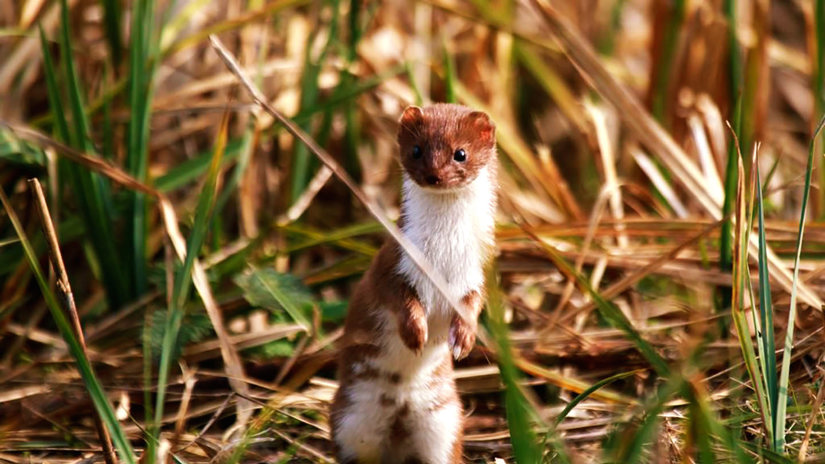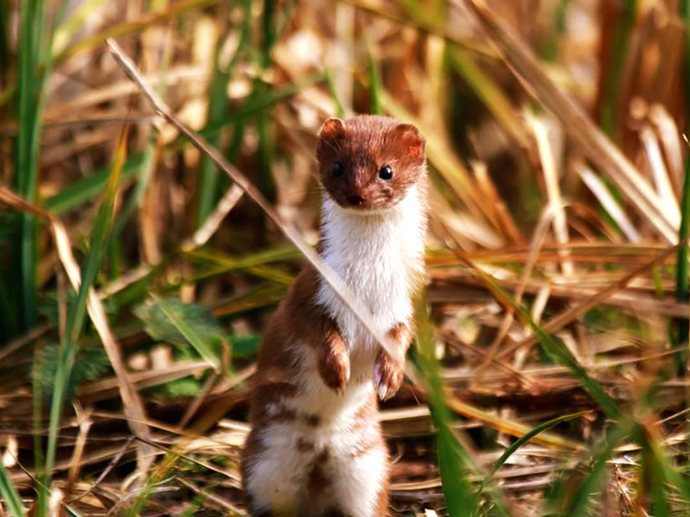Common names: weasel, least weasel, common weasel
Scientific name: Mustela nivalis
Family: Mustelidae
Habitat: woodland, grassland, farmland,
Diet: rodents, rabbits and birds
Predators: foxes and birds of prey
Origin: native
Relentless and always hungry. What they lack in size, weasels make up for in appetite, eating a third of their own body weight daily. From birds to bank voles, the small creatures of the forest floor must be ever wary of this energetic hunter.
Common names: weasel, least weasel, common weasel
Scientific name: Mustela nivalis
Family: Mustelidae
Habitat: woodland, grassland, farmland,
Diet: rodents, rabbits and birds
Predators: foxes and birds of prey
Origin: native
Weasels have chestnut-brown fur with white-cream underparts and a long, slim body that ends in a short tail. These predators are not much bigger than the mice and voles they eat, typically measuring just 20–27cm long. Even the largest male weasel is unlikely to weigh more than 195g, while a small female may be just 50g.
Not to be confused with: the stoat, which is larger and has a longer tail that ends in a bushy black tip. Weasel tails are always wholly brown.


James Martin • 01 Feb 2019
Did you see a stoat on your last woodland walk? Or perhaps it was a weasel? Our guide will help you to tell these pint-sized predators apart. We also take a look at some of the other related species found here in the UK.

Credit: Peter Warne / WTML
Voles and mice are the weasel’s primary prey, with its small size allowing it to follow the rodents into their underground burrows. It can also take larger prey, such as young rabbits, and will readily hunt birds and their eggs too. The weasel has an extremely high metabolism and needs to eat roughly a third of its own body weight daily.
According to rural folklore, some weasels are small enough to squeeze through a wedding ring.
Weasels are solitary and only come together to mate. A litter of around four to six young, known as kits, will be born between April and August. The young are normally raised in a nest or den taken over from the weasel’s rodent prey.
Weaning occurs after three to four weeks and the kits are independent in two to three months.

Credit: Anne Marie Kalus / WTML
Weasels are found throughout Britain, but are absent from Ireland. They can survive in most habitats provided there is plenty of prey to eat and cover to provide shelter from larger predators. Weasels rarely spend long in the open and most of their time is taken up with hunting under the cover of long grass and other vegetation. They will also make use of linear features such as hedgerows and drystone walls to move around their territory.
The weasel is the smallest member of the order Carnivora, which also includes cats, dogs and bears. The largest member, the polar bear, can weigh more than 5,000 weasels combined!
A combination of their small size and habit of sticking to cover means weasels are rarely seen. Most sightings are simply chance encounters. Keep your eyes peeled on your next woodland walk and you may be lucky enough to see one dart across your path in search of its next meal.

Weasels are widespread and thought to be common, but there is a lack of reliable evidence on their numbers. The loss of hedgerows across the UK is one factor that could have a negative impact on the species.